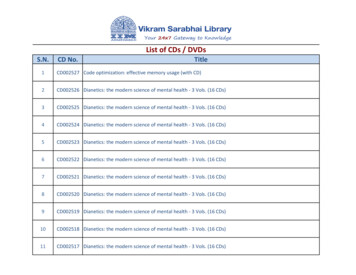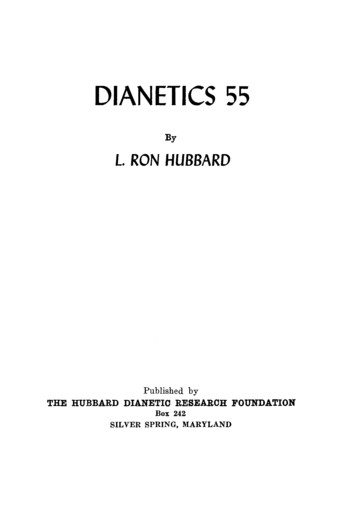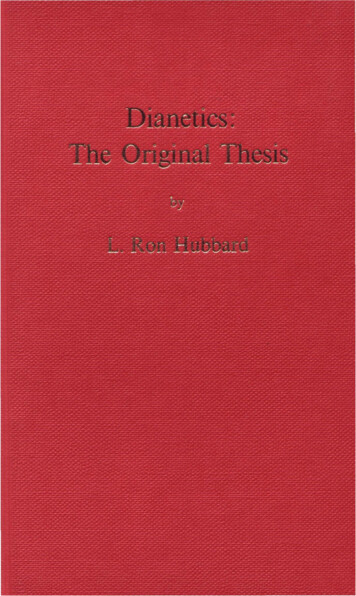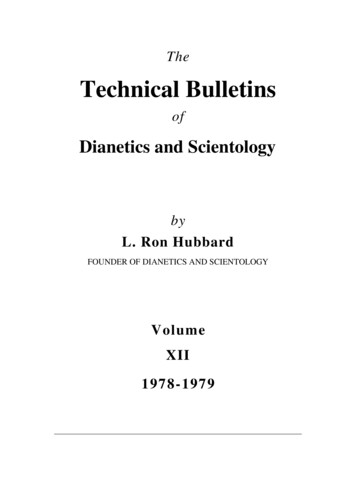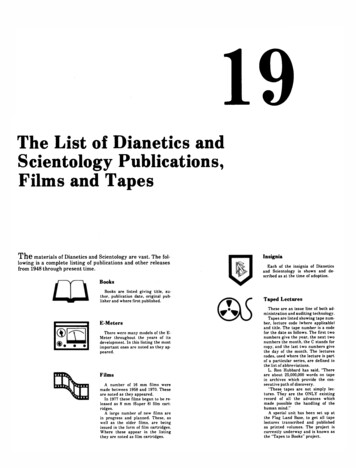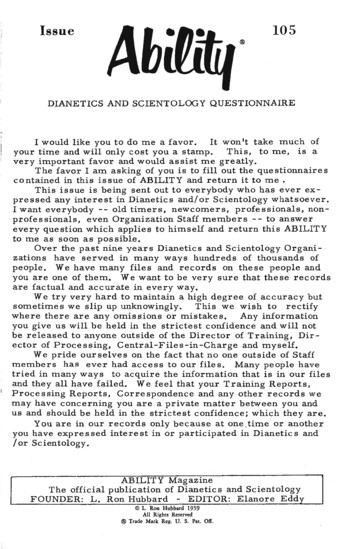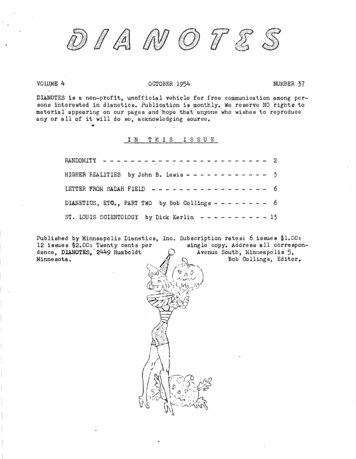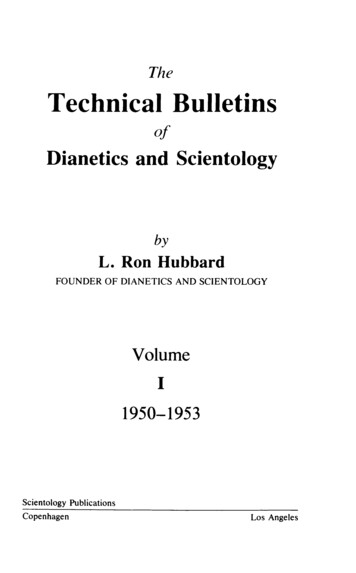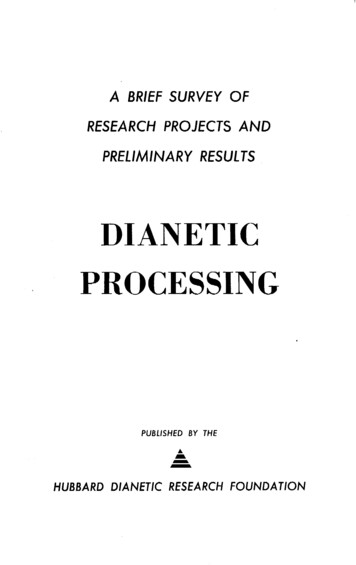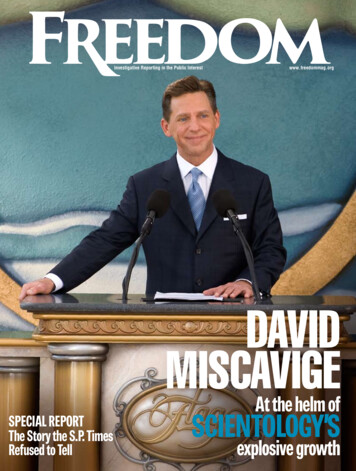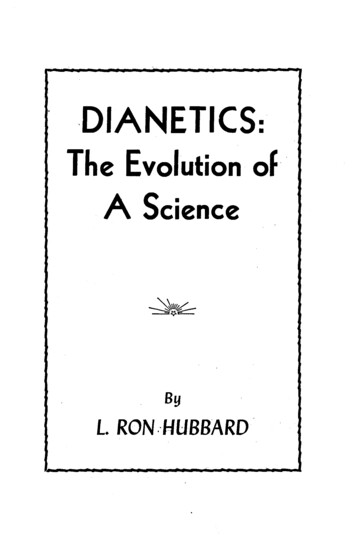
Transcription
. DIANETICS:The Evolution ofAScienceB L. RON .·HUBBARD
From Funk and Wagnall's New StandardDictionary, Supplement No. 5:.di.a.net' .ics: noun. A system for the analysis,control and development of hunian thoughtevolved from a set of coordinated axiomswhich also provide techniques for the treatment of a wide range of mental disorders andorganic diseases : term and doctrines introduced by L. Ron Hubbard, American engineer. (Gr. dianoetikos-dia, di-.a.net'.ic adj.)
DIANETICS:The Evolution ofA ScienceByL. RON HUBBARDPublished byHUBBARD DIANETIC RESEARCH FOUNDATION1017 N. Third St.Phoenix, Arizona, U. S. A.
Copyright, 1955,by L. RON HUBBARDAll Rights ReservedPrinted in the United States of AmericaPrinted ByWICHITA PUBLISHING COMPANY4 1 North Mt1in St.W ich/tt1 2, 1Ct1n1t11
DIANETICS: THE EVOLUTION OF A SCIENCEThe optimum computing machine is a subject which many ofus have studied. If you were building one, how would you design it?First, the machine should be able to compute with perfectaccuracy on any problem in the Universe and produce answerswhich were always and invariably right.Second, the computer would have to be swift, working muchmore quickly than the problem and process could be vocally articulated.Third, the computer would have to be able to handle largenumbers of variables and large numbers of problems simultaneously.Fourth, the computer would have to be able to evaluate itsown data and there would have to remain available within it notonly a record of its former conclusions but the evaluations leadingto those conclusions.Fifth, the computer would have to be served by a memorybank of nearly infinite capacity in which it could store observationaldata, tentative conclusions which might serve future computationsand the data in the bank would have to be available to the analyticalportion of the computer in the smallest fractions of a second.Sixth, the computer would have to be able to rearrange formerconclusions or alter them in the light of new experience.Seventh, the computer would not need an exterior programdirector but would be entirely self-determined about its programming guided only by the necessity-value of the solution whichit itself would determine.Eighth, the computer should be self-servicing and self-armingagainst present and future damage and would be able to estimatefuture damage.Ninth, the computer should be served by perception by whichit could determine necessity-value. The equipment should includemeans of contacting all desirable characteristics in the finite world.This would mean color-visio, tone-audio, odor, tactile and self per 'eptions-for without the last it could not properly service itself.Tenth, the memory bank should store perceptions as perceived,consecutive with time received with the smallest possible time di--3 -
v1s10ns between perceptions. It would then store in color-visio(moving) , tone-audio (flowing) , odor, tactile and self sensation,all of them cross-co-ordinated.Eleventh, for the purposes of solutions, it would have to beable to create new situations and imagine new perceptions hithertonot perceived and should be able to conceive these to itself in termsof tone-audio, color-visio, odor, tactile and self sensation an.clshould be able to file anything so conceived as imagined labeledmemories.Twelfth, its memory banks should not exhaust on inspectionbut should furnish to the central perceptor of the computer, without distortion, perfect copies of everything and anything in thebanks in color-visio, tone-audio, odor, tactile and organic sensations.Thirteenth, the entire machine should be portable.There are other desirable characteristics but those listed abovewill do for the moment.It might be somewhat astonishing, at first, to conceive of sucha computer. But the fact is, the machine is in existence. Thereare about two billion of them in use today and many, many morebillims have been made and used in the past.In fact, you've got one. For we are dealing with the humanmind.The above is a generalization of the optimum brain. Theoptimum brain, aside from the fact that it is not always capableof solving every problem in the Universe, basically works exactlylike that. It should have color-visio (in motion), tone-audio (flowing), odor, tactile and organic memory recall. And it should havecolor-visio (in motion), tone-audio (flowing), odor, tactile and organic imagination, also recallable after imagining like any othermemory. And it should be able to differentiate between actualityand imagination with precision. And it should be able to recall anyperception, even the trivial, asleep and awake from the beginningof life to death. That is the optimum brain, that and much, muchmore. It should think with such swiftness that vocal ponderingwould be utterly unable to keep pace with a thousandth part of onecomputation. And, modified by viewpoint and educational data,it should be always right, its answers never wrong.That is the brain you have, potentially. That is the brainwhich can be restored to you unless you have had some section of-4-
it removed. If it does not do these things, it is slightly out of adjustment.It took a long time to arrive at the data that this was anoptimum brain. In the beginning it was not realized that somepeople had color-visio-moving-recall, for instance, and that somedid not. J, had no idea that many people imagined, and knew theywere imagining, in tone-audio, et cetera, and would have receivedwith surprise the data that somebody could smell and taste lastThanksgiving's turkey when he recalled it.Fifteen years a o, when the researches which culminated inDianetics (Gr. dianoua) thought-were started in earnest, no suchhigh optimum of the human brain was held. In fact, the projectwas not begun to trace brain function and restore optimum operation, but to know the key to human behavior and the code law whichwould reduce all knowledge.My right to enter this field was an inquiring brain which hadbeen trained in mathematics and engineering and which had amemory bank full of questions and far-flung observations.I.t was the basic contention that the human mind was a problem in engineering and that all knowledge would surrender to anengineering approach.And another primary assumption was made:All answers are basically simple.As it stands today, the science of Dianetics and its resultswhich are as demonstrable as the proposition that water, at fifteenpounds per square inch and 212 F. boils-is an engineeringscience, built heuristically on axioms. It works. That is the onlyclaim for Dianetics or chemistry. They may not be True. Butthey work and work invariably in the finite world.When the problem had been shuffled around, in the beginning,and when questions had been formulated to be asked of the Universe at large, there was no concept of the optimum brain. Attention was fixed upon the normal brain. The normal brain was considered to be the optimum brain. Attempts were made, when workfinally got around to the problem of the brain itself, to obtain results comparable with the normal mind. Minds became aberrated.When restored they would be normal.In fact, in the beginning, it was not even certain that minds-5-
could be restored. All that was required was an answer to existence and the reasons minds aberratoo.In a lifetime of wandering around many strange things hadbeen observed. The medicine man of the Goldi people of Manchuria, the shamans of North Borneo, Sioux medicine men, thecults of Los Angeles, and modern psychology. Amongst the people questionoo about existence were a magician whose ancestorsserved in the court of Kublai Khan and a Hindu who could hypnotize cats. Dabbles had been made in mysticism, data had beenstudied from mythology to spiritualism. Odds and ends like these,countless odds and ends.If you were constructing this science, where would you havestarted? Here were all the various cults and creeds aru:l practicesof a whole world to draw upon. Here were facts to a numberwhich makes 1021 binary digits look small. If you were calledupon to construct such a science and to come up with a workableanswer, what would you have assumed, gone to observe, or computed?Everybody and everything seemed to have a scrap of the an·swer. The cults of all the ages, of all the world seem, each one,to contain a fragment of the truth. How do we gather and assemble the fragments? Or do we give up this nearly impossibletask and begin postulating our own answers ?Well, this is the story of how Dianetics was built. This, atleast, was the approach made to the problem. Dianetics works,which is what an engineer asks, and it works all the time, which iswhat nature demands of the engineer.First, attempts were made to discover what school or systemwas workable. Freud did occasionally. So did Chinese apuncture. So did magic healing crystals in Australia and miracleshrines in South America. Faith healing, voodoo, narco-synthesis-and, understand this right here, no mystic mumbo jumbo needapply. An engineer has to have things he can measure. Laterthe word "demon" is used. That's because Socrates describes oneso well. Dianetic use of it, like Clerk-Maxwell's is descriptureslang. But no wild immeasurable guesses or opinions were wanted.When an engineer uses only those, bridges break, buildings fall,dynamos stop and a civilization goes to wrack.A primary need, in arriving at a dynamic principle of existence, was to discover what one wanted to know about existence.One does not have to dabble long with the gods to know that they-6-
point unvaryingly if divinely up a very blind alley. And an engineering study of mysticism demonstrates that mysticism embraces largely what it cannot hope to state precisely.The first proposition went off something on this order. Letus find out what we cannot consider or do not need to consider toget an answer we can use. Some tests seemed to demonstrate thatthe exact identity of the Prime Mover Unmoved was not necessaryto the computation. Man has been convinced for a long time thatHe started this affair, so no great gain could be made in gettingdisputive about it. Let us then take a level immediately below thePrime Mover Unmoved.Now let us see what else falls into the category of data unnecessary to the computation. vVell, we've studied telepathy, demons,the Indian rope trick and the human soul and so far we have yetto find any constants in this class of data. So let us draw a linebelow that as our highest level of necessary information and nowcall this our highest line.What do we have left? We have the finite world, blue sergesuits, Salinas Valley, the Cathedral at Rheims as a building andseveral decayed empires and roast beef for dinner. We have leftonly what we can perceive with no higher level of abstraction.Now, how do we perceive and on what and with what? Ensues here a lot of time spent-1937-in computing out the brain asan electronic calculator with the probable mathematics of its operation plus the impossibility of such a structure capable of doingsuch things. Let us then rule out the necessity of knowing structure and use this as an analogy only which can become a variablein the equation if necessary.Now what do we have? Well, we've been a little hard ondemons and the human soul. These are popular but they refuse tostand out and submit to a thorough inspection and caliper mensuration and if they won't so co-operate, then neither will we. Andso two things come from this reduction of equation factors necessary to solution. First, existence is probably finite and second,finite factors alone answered the need of the problem.Probably we could be very obstuse and mathematical here, butno matter. A good, workable heuristic principle, a workable one,is worth an infinity of formulas based on Authority and opinionswhich do not work.All we can do is try the principle. We need a dynamic prin--7-
cicle of existence. We look in Spencer and we find somethingwhich reads awfully good. J,t read good when he took it fromIndian writings, the same place Lucretius got it. But it only pretends to be dynamic because it doesn't compute. We need adynamic principle, not a description.But what does a principle mean in a sphere this large? Anddoesn't it need a better definition? Let us then call it a dynamiclowest common denominator of existence.Will such a lowest common denominator lead us straight upabove the highest level we have set and send us spinning off witha fist full of variables and no answer? It had better not. So let uspose some more questions and see if they clarify the principle.What can we know? Can we know where life came from?Not just now. Can we know where life is going? Well, thatwould be interesting but few of us will live to see that. So what canwe know? Who, when, why, where, what-WHAT! We canknow WHAT life is doing.Let us postulate now that life started somewhere and is going somewhere. To know where it came from might solve a lotof problems but that seems unnecessary to know at this time forthis problem. And the somewhere might be known too some daybut again we do not neoo to know that. So now we have something for the equation which will stay in terms of constants.WHAT is life doing enroute?Life is energy of some sort. The purpose seems to involveenergy. We are being heuristic. No arguments necessary because all we want is something with a high degree of workability,that's all any scientist needs. If this won't work, we'll dream upanother one and postulate and postulate until something does work.What is energy doing? It's surviving-changing form, butsurviving.What is life doing? It's surviving.Now maybe it is doing a whole lot more, but we'll just trythis on for size. What is the lowest common denominator of allexistence which we have so far found?SURVIVE!The only test of an organism is survival.That can be computed.-8-
·--."'.We can even go so far as to make it colorful and say thatthere was a beginning of track and at this beginning of trackSomebody said SURVIVE I He didn't say why and He didn'tsay until. All He said was SURVIVE!Well, that's simple and it computes. I.t makes sense on theslide rule and it makes sense with a lot of activity and it seemspretty good-let's see.The brain was a computer-director evolved on the same principles and on the same plan as cells and by cells and is composedof cells. The brain resolved problems relating to survival, askeditself questions about survival, acted upon its own best conceivedbut personally viewpointed plan for survival.If one sagged down toward unsurvival, .one was goaded up thescale toward survival by pain. One was lured ahecul by pleasureinto survival. There was a graduated scale with one end in deathand the other in immortality.The brain thought in terms of differences, similarities andidentities and all its problems were resolved on these lines and allthese problems and all these activities were strictly and solely survival-motivated. The basic command data on. which the body andbrain operated was SURVIVE! That was all; nothing fell outsidethis.It was postulated to see if it worked.That was in 1938 after several years of study. The axiomsbegan with SURVIVE! SUR.VIVE was the lowest commondenominator of all existence. They proceeded through axioms asto what man was doing and how he was doing it. Nice definitionsfor intelligence, drive, happiness, good, evil and so forth fell intoline. Suicide, laughter, drunkenness and folly all fell inside this,too, as it computed out.These computations stood the tests of several years. Andthen, as you may have heard, came a war. But even wars end.Research was resumed, but now with the added necessity of applying the knowledge gained to the problems of friends who had notsurvived the war too well.A researcher gets out on a rim of the unknown just so far andthe guide books run out. In the libraries were thousands andthousands of mental cases, neatly recorded. And not one case contained in it the essential data to its solution. These cases might justas well have been written in nishing ink for all the good they-9-
were. Beyond proving conclusively that people manifested strangemental aberrations they were worthless. How do you go aboutbuilding a science of thought without being permitted to observeand without having any observoo data?Out of a multitude of personal observations in this and distant lands, it was the first task to find a constant. I had studiedhypnotism in Asia. I, knew hypnotism was, more or less, a fundamental. Whenever shamans, medicine men, exorcists or evenmodern psychologists go to work, they incline toward practiceswhich are hypnotic.But of what use is such a terrible, unpredictable variable ashypnotism. On some people it works. On most it doesn't. Onthose on whom it works it sometimes achieves good results, sometimes bad. Wild stuff, hypnotism.The physical scientist, however, is not unacquainted with theuse of a wild variable. Such erratic things usually hide real, important laws. Hypnotism was a sort of constant thread throughall the cults-or hypnotic practices-but perhaps one might at leastlook at it.So hypnotism \'lras examined. A wild radical. The reason itwas wild might be a good answer. The first investigation of it wasquite brief. It did not need to be longer.Examine a post-hypnotic suggestion. Patient in amnesia trance.Tell him that when he awakens he will remove his left shoe andput it on the mantel. Then tell him that he will forget he has beentold and wake him up. He awakens, blinks for a while and thenputs his foot forward and removes his shoe. Ask him why. "Myfoot's too hot." He puts the shoe on the mantel. Why? "J, hateto put on a damp shoe. \Varmer up here and it will dry." Keepthis in mind, this experiment. The full reason for its importancedid not appear for nine years. But it was recognized that, withvarious suggestions, one could create the appearance of variousneuroses, psychoses, compulsions and repressions listed by thepsychiatrist. The examination promptly went no further. Onehad too few answers yet. But it was clear, that hypnotism and insanity were, somehow, identities. A search was begun for thereason why.For a long time and with many, many people attempts weremade to unlock the riddle. What caused hypnotism? What didit do? Why did it behave unpredictably?-10-
Examination was made of hypno-analysis. It sounds goodin the texts but it doesn't work. It doesn't work for several reasons, first among them being that you can't hypnotize everybody.Further it works only occasionally, even when a person can behypnotized. So hypno-analysis was buried along with the watercure of Bedlam and the pre-frontal lobotomy and the demon-extraction techniques of the shamans of British Guiana and thesearch for the key which could restore a mind to normal was continued.But hypnotism wouldn't stay quite dead. Narco-synthesisseemed a good lead, until some cases were discovered which hadbeen "cured" by narco-synthesis. They were re-worked with thetechnique just to discover what had occurred. Narco-synthesissometimes seemed to fix a man up so his war neurosis could rise toeven greater heights at some future date. No, that is not entirelyfair. It produces slightly higher results than a magic healingcrystal iii the hands of an Australian medicine man. It seemed to lo something beyond what it was supposed to do, and that something beyond was bad. Here was another wild variable, a piece ofthe puzzle of insanity's cause. \Ve knew WHAT man was doing.He was surviving. Someho''" some way, he occasionally becameirrational. \Vhere did hypnotism fit into this? Why did drughypnotism affect people so adversely at times?These people one met and worked with did seem to be trappedsomehow by something which modern methods almost nevertouched. An.d why did whole nations rise up to slaughter nations?And why did religious zealots carry a banner and crescent acrossthree quarters of Europe? People behave as if they'd been cursedby something. Were they basically evil? Was social training athin veneer? vVas the evil curse a natural inheritance from thetooth and claw animal kingdom? Was the brain ever capable ofrationality? Hypnotism an.d narco-synthesis, unpredictable radicals, refused for a time to divulge answers.Out of orbit again and without tools with which to work, itwas necessary to hark back to the techniques of the Kayan Shamanof Borneo, amongst others. Their theory is crude; they exorcisedemons. All right. We postulated that man is evil, that the evilis native. Then we oug-ht to be able to increase the civilized veneerby planting in him more civilization, using hypnotism. So thepatient usually gets worse. That postulate didn't work. Provisional, let's try the postulate that man is good and follow its conclusions. And we suppose something such as the Borneo Shaman's-11-
Toh has entered into him which directs him to .do evil things.Man has believed longer that demons inhabit men than manhas believed they did not. We assume demons. We look for somedemons, one way or another. And we found some!This was a discovery almost as mad as some of the patientson hand. But the thing to do was try to measure and classifydemons.Strange work for an engineer and mathematician! But it wasfound that the "demons" could be classified. There were several"demons" in each patient, but there were only a few classes of"demons". There were audio-demons, sub-audio demons, visiodemons, interior demons, exterior demons, ordering demons, directing demons, critical demons, apathetic demons, angry demons,bored demons and "curtain" demons who merely occlude l things.The last seemed the most common. Looking into a few mindsestablished soon that it was difficult to find anyone who didn'thave some of these demons.It was necessary to set up an optimum brain. That brainwould be postulated, subject to change. It would be the combinedbest qualities of all brains studied. I.t would be able to visualize incolor and hear with all tones and sounds present, all memoriesnecessary to thought. It would think without talking to itself,thinking in concepts and conclusions rather than words. It wouldbe able to imagine visually in color anything it cared to imagineand hear anything it cared to imagine it would hear. It was discovered eventually that it could also imagine smells and tactiles butthis did not enter into the original. Finally it would know whenit was recalling and know when it was imagining.Now, for purposes of analogy it was necessary to go back to.the electronic computer idea conceived in 1938. Circuits weredrawn up for the visio and audio recall, for color and tone recall,for imagination visio and audio creation and color and tone creation. Then were drawn the memory bank circuits. All this wasfairly easy at this time since some extensive work had been doneon this in the thirties.With this diagram, further circuits were set up. The optimumbrain was a plain circuit. To this were added the "demon" circuits. It was found that by very ordinary electronics one couldinstall every kind of a "demon" that had been observed.The "demons," since none of them consented to present them'---12 -
selves for a proper examination as demons, were, it was concluded,installed in the brain in the same way one would install a newcircuit in the optimum brain. But as there was just so much brain,is was obvious that these electronic "demons" were using parts ofthe optimum brain and that they were no more competent than theoptimum brain inherently was. This was more postulating. Allone wanted was a good result. If this hadn't worked somethingelse would have been tried.Thus the solution was enteroo upon. While the human brainis a shade too wonderful an instrument to be classified with anything as clumsy as contemporary electronics, as marvelous as modern electronics are, the analogy stands. It stands as an analogy.The whole science would hang together brightly now without thatanalogy. But it serves in this place.There are no demons. No ghosts and ghouls or Tohs. Butthere are aberrative circuits. So it was reasoned. It was a postulate. And then it became something more.One day a patient fell asleep. When he awakened he wasfound to be "somebody else." As "somebody else" he was questioned very carefully. This patient, as "himself", had a sonicmemory block, an audio memory block, and was color-blind. Hewas very nervous ordinarily. Just now, awakenoo into being"somebody else" he was calm. He spoke in a lower voice tone.Here, obviously, one was confronting one of these electronic screwups the savants call schizophrenics. But not so. This was thebasic personality of the patient himself, possessed of an optimumbrain!I.t was very rapidly established that he had color-visio recallon anything, tone-audio recall, tone-audio and color-visio imagination and entire co-ordinative control. He knew when he wasimagining and when he was recalling and that, too, was somethinghe had not been able to do before.He wanted to know something. He wanted to know whenthe operator was going to help him get himself squared around.He had a lot of things to do. He wanted to help his wife out soshe ·wouldn't have to support the family. How unlike the patientof an hour before!He obligingly did some mental computations with accuracyand clarity and then he was permitted to lie down and sleep. Hewoke up with no recollection of what had happened. He had hisold symptoms. Nothing could shake those electronic blocks. He-13-
didn't even know if he had eaten lunch, the color of my scarf, andas for his wife, served her right for being a condemned woman.This was a first introduction to basic personality. It was along way from a last acquaintance. It was found that it was possible to contact optimum brain operation in a number of people.And the basic personalities contacted were invariably strong,hardy, and constructively good! They were the same personalitiesas the patients had in a normal state minus certain mental powers.plus electronic demons and plus general unhappiness. I foundthat a "hardened criminal" with an obvious "criminal mind" was,in basic personality, a sincere, intelligent being with ambition andco-operativeness.This was incredible. If this was basic brain, then basic brainwas good. Then man was basically good. Social nature was inherent ! If this was basic brainI twas. That is a "clear." But we pull ahead of the story.People were uniformly miserable being aberrated. The mostmiserable patient on the rolls had an aberration that maide her act"happy" and the most nervous aberee one would ever care to encounter had a mastering aberration about being always "calm."She said she was happy and tried to make herself and everyone believe it. He said he was calm. He instantly flew into a nervousfit if you told him he wasn't calm.Tentatively and cautiously a conclusion was drawn that theoptimum brain is the unaberrated brain, that the optimum brainis also the basic personality, that the basic personality, unless organically deranged, was good. If man were basically good, thenonly a "black enchantment" could make him evil?VVhat was the source of this enchantment?Did we admit superstitions and demons as actualities and suppose the source was something weird and wonderful in the way ofectoplasm? Or did we part company with many current beliefsand become something a little more scientific?The source, then, must be the exterior world. A basic personality, so anxious to be strong, probably would not aberrate itselfwithout some very powerful internal personal devil at work Butwith the devils and "things that go boomp in the night" heavedinto the scrap heap, what did we have left? There was the exterior world and only the exterior world.Good enough: we'll see if this works again. Somehow the-14-
exterior world gets interior. The individual becomes possessed ofsome unknowns which set up circuits against his consent, the individual is aberrated, and is less able to survive.The next hunt was for the unknown factor. The track lookedpretty fair, so far, but the idea was to formulate a science, ofthought. And a science, at least to an engineer, is something prettyprecise. It had to be built on axioms to which there are preciousfew, if any, exceptions. It has to produce predictable results uniformly and every time.Perhaps engineering sciences are this way because naturalobstacles oppose the engineer, and matter has a rather unhandyway of refusing to be overlooked because someone has an opinion.If an engineer forms an opinion that trains can run in thin air andso omits the construction of a bridge across a stream, gravity isgoing to take over and spill one train into one stream.Thus, if we are to have a science of thought, it is going to benecessary to have workable axioms which, applied with techniques,will produce uniform results in all cases and produce them invariably.A great deal of compartmentation of the problems had alreadybeen done, as previously mentioned or in the course of the work.This was necessary in order to examine the problem proper whichwas man in the Universe.First we divided what we could probably think about and hadto think about from what we probably didn't have to think about,for purposes of our solution. Next we had to think about all men.Then a few men. Finally the individual man and at last a portionof the aberrative pattern of an individual man.How did the exterior world become an interior aberration?There were many false starts and blind passages just as therehad been in determining what an optimum brain would be. Therewere still so many variables and possible erroneous combinationsin the computation that it looked like something out of Kant. Butthere is no argument with results. There is no substitute for abridge heavy enough to hold a train.I tried, on the off-chance that they might be right, severalschools of psychology-Jung, Adler. Even Freud. But notvery seriously because over half the patient
Dianetics (Gr. dianoua) thought-were started in earnest, no such high optimum of the human brain was held. In fact, the project was not begun to trace brain function and restore optimum opera tion, but to know the key to
